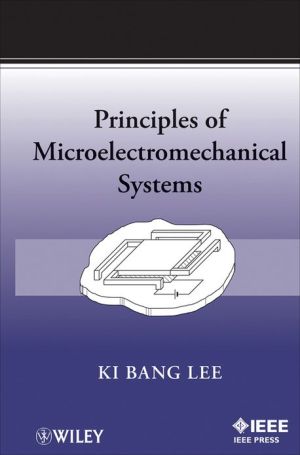

 |

|

Sold Out
Book Categories |
PREFACE.
1 INTRODUCTION.
1.1 Microelectromechanical Systems.
1.2 Coupled Systems.
1.3 Knowledge Required.
1.4 Dimensional Analysis.
Problems.
2 MICROFABRICATION.
2.1 Bulk and Surface Micromachining.
2.2 Lithography.
2.3 Layer Deposition.
2.4 Layer Etching.
2.5 Fabrication Process Design.
Problems.
3 STATICS.
3.1 Static Equilibrium.
3.2 Stress–Strain Relationship.
3.3 Thermal Stress.
3.4 Beam Behavior Subjected to a Torsional Moment.
3.5 Moment–Curvature Relationship.
3.6 Beam Equation.
3.7 Galerkin's Method.
3.8 Energy Method.
3.9 Energy Method for Beam Problems.
Problems.
4 STATIC BEHAVIOR OF MICROSTRUCTURES.
4.1 Elements of Microstructures.
4.2 Stiffness of Commonly Used Beams.
4.3 Trusses.
4.4 Stiffness Transformation.
4.5 Static Behavior of Planar Structures.
4.6 Residual Stress.
4.7 Cubic Force of Structures.
4.8 Potential Energy.
4.9 Analogy Between Potential Energies.
Problems.
5 DYNAMICS.
5.1 Cubic Equation.
5.2 Description of Motion.
5.3 Governing Equations of Dynamics.
5.4 Energy Conversion Between Potential and Kinetic Energy.
5.5 Free Vibration of Undamped Systems.
5.6 Vibration of Damped Systems.
5.7 Multidegree-of-freedom systems.
5.8 Continuous Systems.
5.9 Effective Mass, Damping, and Stiffness.
5.10 Systems with Repeated Structures.
5.11 Duffi ng's Equation.
Problems.
6 FLUID DYNAMICS.
6.1 Viscous Flow.
6.2 Continuity Equation.
6.3 Navier–Stokes Equation.
6.4 Reynolds Equation.
6.5 Couette Flow.
6.6 Oscillating Plate in a Fluid.
6.7 Creeping Flow.
6.8 Squeeze Film.
Problems.
7 ELECTROMAGNETICS.
7.1 Basic Elements of Electric Circuits.
7.2 Kirchhoff’s Circuit Laws.
7.3 Electrostatics.
7.4 Force and Moment Due to an Electric Field.
7.5 Electrostatic Forces and Moments Acting
on Various Objects / 395
7.6 Electromagnetic Force / 410
7.7 Force Acting on a Moving Charge in Electric and
Magnetic Fields / 418
7.8 Piezoresistance.
7.9 Piezoelectricity.
Problems.
8 PIEZOELECTRIC AND THERMAL ACTUATORS.
8.1 Composite Beams.
8.2 Piezoelectric Actuators.
8.3 Thermal Actuators.
Problems.
9 ELECTROSTATIC AND ELECTROMAGNETIC ACTUATORS.
9.1 Electrostatic Actuators.
9.2 Comb Drive Actuator.
9.3 Parallel-Plate Actuator.
9.4 Torsional Actuator.
9.5 Fixed–Fixed Beam Actuator.
9.6 Cantilever Beam Actuator.
9.7 Dynamic Response of Gap-Closing Actuators.
9.8 Approximation of Gap-Closing Actuators.
9.9 Electromagnetic Actuators.
Problems.
10 SENSORS.
10.1 Force and Pressure Sensors.
10.2 Accelerometers.
10.3 Electrostatic Accelerometers.
10.4 Vibratory Gyroscopes.
10.5 Other Issues.
Problems.
APPENDIX.
REFERENCES.
INDEX.
Login|Complaints|Blog|Games|Digital Media|Souls|Obituary|Contact Us|FAQ
CAN'T FIND WHAT YOU'RE LOOKING FOR? CLICK HERE!!! X
 You must be logged in to add to WishlistX
 This item is in your Wish ListX
 This item is in your CollectionPrinciples of Microelectromechanical Systems
X
 This Item is in Your InventoryPrinciples of Microelectromechanical Systems
X
 You must be logged in to review the productsX
 X
 X

Add Principles of Microelectromechanical Systems, The building blocks of MEMS design through closed-form solutions Microelectromechanical Systems, or MEMS, is the technology of very small systems; it is found in everything from inkjet printers and cars to cell phones, digital cameras, and medical equi, Principles of Microelectromechanical Systems to the inventory that you are selling on WonderClubX
 X

Add Principles of Microelectromechanical Systems, The building blocks of MEMS design through closed-form solutions Microelectromechanical Systems, or MEMS, is the technology of very small systems; it is found in everything from inkjet printers and cars to cell phones, digital cameras, and medical equi, Principles of Microelectromechanical Systems to your collection on WonderClub |